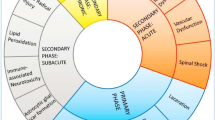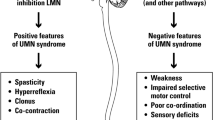Abstract
The purpose of this study was to develop a spinal cord injury model in the mouse. Various degrees of extradural compression were used to induce mild, moderate or severe compression injuries. Furthermore, a locomotor rating scale was developed by which the functional outcome of the spinal cord injury could be assessed. The introduction of such a model will be useful for further studies on the pathogenesis and treatment strategies of spinal cord injury. To assess hindlimb motor function, a 10-point scale was used. Initially, the animals were allowed to move freely in an open field and were rated 0–5, 0 being no movement and 5 being almost normal. Animals scoring a 5 were then assessed using steel bars with decreasing widths from 2 cm to 5 mm. For each bar successfully crossed over, they gained additional points. Before injury the hindlimb motor function score (MFS) in all the animals was 10. In mice with mild compression, MFS was decreased slightly on day 1 and recovered to 9 ± 0.6 on day 14. For mice with moderate compression, the MFS decreased to 4.6 ± 0.4 on day 1 after injury and gradually improved to 8.1 ± 0.6 on day 14. Severe injury resulted in paraplegia of the hindlimbs day 1 after injury with a score of 0.6 ± 0.2. By day 14 after injury, these animals gradually recovered to 3.9 ± 0.1, could bear the weight on the hindlimbs and walk with a severe deficit. There was a 3%, 9% and 19% decrease in the total cross-sectional area of the spinal cord 14 days after mild, moderate and severe injury, respectively. Microtubule-associated protein immunostaining revealed that the gray matter decreased to 61 ± 7% in moderately injured animals, while severe compression resulted in a complete loss of gray matter. White matter decreased to 86 ± 6% in moderately injured animals and 29 ±11% in severely injured animals. This study shows that the mouse can be used to achieve reproducible spinal cord compression injuries of various degrees of severity. The force of the impact correlates well with the neurological and light microscopic outcome. The motor function test presented in this paper and the computerized quantification of tissue damage can be used to evaluate the efficacy of different treatment strategies.
Similar content being viewed by others
Author information
Authors and Affiliations
Additional information
Received: 2 December 1998 / Revised, accepted: 14 October 1999
Rights and permissions
About this article
Cite this article
Farooque, M. Spinal cord compression injury in the mouse: presentation of a model including assessment of motor dysfunction. Acta Neuropathol 100, 13–22 (2000). https://doi.org/10.1007/s004010051187
Issue Date:
DOI: https://doi.org/10.1007/s004010051187




